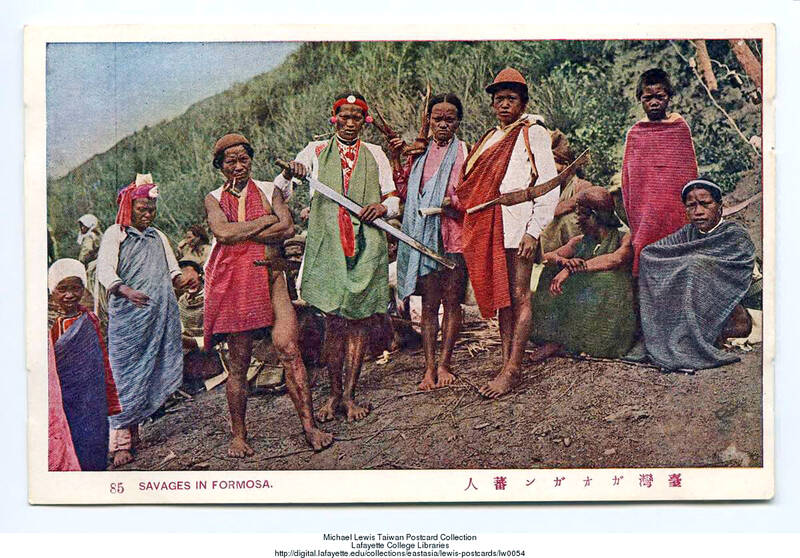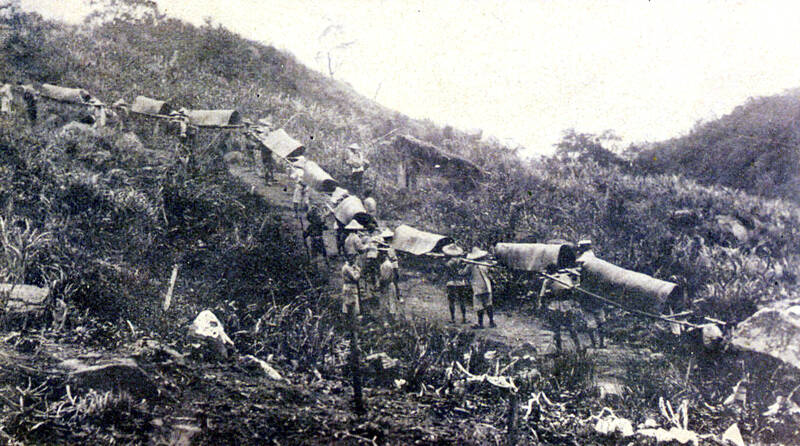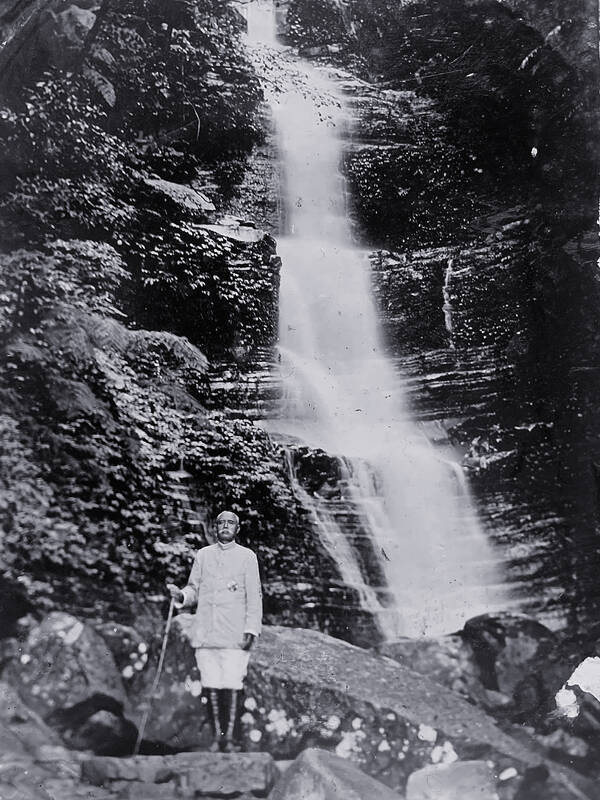Aug. 19 to Aug. 25
The situation was getting increasingly dire for the indigenous Mrqwang and Mknazi Atayal living near Hsinchu County’s Lidong Mountain (李崠山). Largely left alone during the first decade of Japanese colonization, they watched as their northern brethren fell one by one under the aggressive leadership of governor-general Samata Sakuma, who assumed the position in 1906.
In late 1910, the Japanese defeated their close allies, the Mkgogan, and although the Mrqwang and Mknazi managed to repel an invasion the following year, the Japanese constructed frontier defenses and three hilltop fortresses with cannons aimed directly at their villages.

Photo courtesy of Lafayette Digital Repository
After a powerful typhoon in August 1912 devastated Japanese frontline infrastructure and equipment, the Atayal struck back. They launched a coordinated attack on a 10km-stretch of the defense line, seizing one of the forts and pushing the cannons into the ravine. They then destroyed the remaining structures and set the gunpowder on fire, the loud explosions ringing through the ravines.
The win was short-lived as Japanese reinforcements soon arrived. By July 1913, the colonizers had full control over the region, ending the series of conflicts involving at least five Atayal groups now known as the Lidongshan Incident (李崠山事件, also known as the Tapung Incident).
It was the final stand for the northern Atayal, who were forcefully relocated so the government could exploit the region’s valuable timber and camphor.

Photo courtesy of National Central Library
COVETED MOUNTAIN
Like the Qing Dynasty, the Japanese did not have full control over the mountainous indigenous areas. Sakuma, however, vowed to change that.
With superior numbers and firepower, the Japanese first targeted Atayal groups living in the southern part of today’s New Taipei City and eastern Taoyuan, prevailing in 1908 after a bloody two-year campaign.

Photo courtesy of Wikimedia Commons
But Sakuma was not satisfied. In April 1910, he announced the “five year plan to govern the savages,” which aimed to bring every independent indigenous group in Taiwan under government control.
Ethnologist Daya Dakasi (better known as Kuan Da-wei, 官大偉) details the Tapung Incident in his 2019 book Zyaw pinttriqan nqu llingay Tapung (李崠山事件).
The term “Tapung” refers to branches snapping under thick snow. The traditional territory of the Mrqwang, Mknazi and Mkgogan met in this area, and the three enjoyed a close relationship, often banding together to resist invaders.

Photo courtesy of Lafayette Digital Repository
The Japanese wanted Lidong Mountain not just for its trees. Camphor harvesters from Yilan, Taoyuan and Hsinchu all had to pass through the area, where they were often attacked by the Atayal who wanted to stem their encroachment. As the highest local point at 1,913m, the Japanese could set up artillery batteries at the top to keep the surrounding villages in line.
“The Japanese attacked the Atayal to seize our land, to fell our trees,” Paqiy Village resident Liu Jen-ching (劉仁青) tells Daya Dakasi. “Without land and without trees, there would be no more Atayal. Of course our ancestors had to fight.”
ASSAULTS ON TAPUNG
The 1,000-strong Mkgogan were partially subdued in previous conflicts, but many continued to fight, fleeing beyond the defense lines and attacking frontier guards, police stations and road workers.
The Japanese decided to deal with them first. To prevent allies from coming to their aid, they closed in from two sides in May 1910. A contingent of about 3,000 troops from Yilan focused on the Mkgogan, while a force of 1,200 from Hsinchu dealt with the Siakaro and Maibarai. The Hsinchu brigade achieved its objective within a month, but the Yilan brigade was having trouble. The Japanese sent reinforcements from Hsinchu, but they were attacked en route by the Mrqwang. The Atayal resistance was fierce, but by September, the Japanese had seized the saddle area of Lidong Mountain.
The tide turned as 1,300 more troops arrived from Taoyuan, and in late October, the Japanese held a surrendering ceremony, where the Mkgogan handed over their firearms. They called for the Mrqwang and Mknazi to do the same, but the two had agreed to refuse and continue fighting.
The Japanese set up a fort and battery on Balung Mountain, from where they could fire at all three groups. Meanwhile, the Mrqwang and Mknazi launched sporadic attacks throughout the year.
On Aug. 2, 1911, a force of over 2,000 made its way toward Lidong Mountain. One contingent successfully took the peak and began constructing fortifications, but the others struggled as the Mkgogan sent warriors to help despite their previous surrender. The Japanese repeatedly tried to rush up the peak, but the Atayal ambushed them from above and engaged them in hand-to-hand combat. Only a handful of Japanese made it to the top.
The Japanese were further hampered by inclement weather, which knocked out their telecommunication lines. The fighting concluded in November, and although the Japanese failed to subjugate either group, they built three mountaintop batteries that would greatly aid their future operations.
FINAL PHASE
The 1912 Atayal offensive was successful at first, but they were driven back behind the defense line on Oct. 1.
The Japanese pushed forward on Oct. 3, but by this time the Atayal had learned a thing or two from their enemy as they began building similar mountaintop fortifications. This battle lasted until Dec. 13, concluding with the surrender of the Mrqwang. The Japanese then expanded the forts on Balung and Lidong mountains and added several smaller ones on the nearby hills.
Only the Mknazi remained, numbering around 630. The Japanese struck on June 25, 1913 with a 2,780-strong force, but they struggled against the much smaller Atayal resistance. On July 7, Sakuma personally arrived at the battlefield, setting up command headquarters at Tapung Fort (formerly known as the Lidong Moutain Fort).
Around this time, the Mknazi fighters multiplied in number — their close relatives, the previously surrendered Siakaro, had sent help. But the Japanese called for even more help, and by July 17, the Atayal began surrendering and turning in their firearms.
After the war, the Japanese sought to erode the ties between the groups. In one instance, they took advantage of a hunting grounds dispute between the Mrqwang and Mknazi, supplying them with guns to widen the conflict before stepping in as mediator. They also relocated the villages to lower ground and encouraged them to farm rice, greatly altering their lifestyle.
Today, Lidong Mountain is popular among hikers, listed among Taiwan’s “Small 100 Peaks” (小百岳) under 3,000m. The Tapung Fort still stands today and became a historic relic in 2003.
Taiwan in Time, a column about Taiwan’s history that is published every Sunday, spotlights important or interesting events around the nation that either have anniversaries this week or are tied to current events.

US President Donald Trump may have hoped for an impromptu talk with his old friend Kim Jong-un during a recent trip to Asia, but analysts say the increasingly emboldened North Korean despot had few good reasons to join the photo-op. Trump sent repeated overtures to Kim during his barnstorming tour of Asia, saying he was “100 percent” open to a meeting and even bucking decades of US policy by conceding that North Korea was “sort of a nuclear power.” But Pyongyang kept mum on the invitation, instead firing off missiles and sending its foreign minister to Russia and Belarus, with whom it

Many people noticed the flood of pro-China propaganda across a number of venues in recent weeks that looks like a coordinated assault on US Taiwan policy. It does look like an effort intended to influence the US before the meeting between US President Donald Trump and Chinese dictator Xi Jinping (習近平) over the weekend. Jennifer Kavanagh’s piece in the New York Times in September appears to be the opening strike of the current campaign. She followed up last week in the Lowy Interpreter, blaming the US for causing the PRC to escalate in the Philippines and Taiwan, saying that as

When Taiwan was battered by storms this summer, the only crumb of comfort I could take was knowing that some advice I’d drafted several weeks earlier had been correct. Regarding the Southern Cross-Island Highway (南橫公路), a spectacular high-elevation route connecting Taiwan’s southwest with the country’s southeast, I’d written: “The precarious existence of this road cannot be overstated; those hoping to drive or ride all the way across should have a backup plan.” As this article was going to press, the middle section of the highway, between Meishankou (梅山口) in Kaohsiung and Siangyang (向陽) in Taitung County, was still closed to outsiders

The Chinese Communist Party (CCP) has a dystopian, radical and dangerous conception of itself. Few are aware of this very fundamental difference between how they view power and how the rest of the world does. Even those of us who have lived in China sometimes fall back into the trap of viewing it through the lens of the power relationships common throughout the rest of the world, instead of understanding the CCP as it conceives of itself. Broadly speaking, the concepts of the people, race, culture, civilization, nation, government and religion are separate, though often overlapping and intertwined. A government